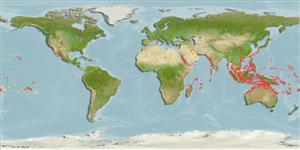分類 / Names
共通名の | 類義語 | Catalog of Fishes(部類, 種) | ITIS | CoL | WoRMS | Cloffa
>
Ovalentaria/misc (Various families in series Ovalentaria) >
Plesiopidae (Roundheads) > Plesiopinae
Etymology: Calloplesiops: Greek, kalos, kallos = beautiful + Greek, plesios = near, neighbour + Greek, ops = appearance (Ref. 45335).
More on author: Steindachner.
Environment: milieu / climate zone / depth range / distribution range
生態学
海 関連する礁; 深さの範囲 3 - 110 m (Ref. 48635), usually 3 - 45 m (Ref. 27115). Tropical; 32°N - 24°S
Indo-Pacific: Red Sea and East Africa to Tonga and the Line Islands.
サイズ / 重さ / 年齢
Maturity: Lm ? range ? - ? cm
Max length : 20.0 cm TL オス/雌雄の選別がない; (Ref. 48635); 最大記録サイズ: 9 年
背面の脊椎 (合計): 11; 背鰭 (合計): 8-10; 肛門の骨 3; 臀鰭: 9. Characterized by having tubed lateral-line scales 19-20+9-10; depth of body 2.5-2.7 in SL; dorsal and anal fins elevated posteriorly; rounded caudal fin. The false eye which is actually the dorsal fin ocellus confuses predators because it poses an inverted image of a fish. When alarmed, this fish will poke its head into a hole and expose its tail end which mimics the head of the moray eel (Ref. 9710). Head and body brownish black with small pale blue spots; vertical and pelvic fins dark orange-brown, with many small blue spots; blue ringed black ocellus above base of last 3 dorsal rays; yellow spots at base of upper caudal rays; pectoral rays bright yellow, fin membrane transparent (Ref. 10430).
Adults are found near reefs, and in caves and crevices along drop-offs (Ref. 8631). A nocturnal species that hides under ledges and in holes by day (Ref. 9710). They possess a false eye which is actually the dorsal fin ocellus confuses predators because it poses an inverted image of a fish. When alarmed, this fish will poke it's head into a hole and expose its tail end which mimics the head of the moray eel (Ref. 9710). Eggs are guarded by the male parent (Ref. 205). Have been reared in captivity (Ref. 35426). Reported to be living in a marine aquarium for 8 years and 6 months (Danilo Ronchi, Italy, pers.comm. 2014 February). Maximum depth reported taken from Ref. 128797.
Life cycle and mating behavior
成熟 | 繁殖 | 放精 | 卵 | 生産力 | 幼生
Eggs are guarded by the male parent (Ref. 205).
Randall, J.E., G.R. Allen and R.C. Steene, 1990. Fishes of the Great Barrier Reef and Coral Sea. University of Hawaii Press, Honolulu, Hawaii. 506 p. (Ref. 2334)
IUCNのレッドリストの状況は (Ref. 130435)
Warning: mysqli::__construct(): (08004/1040): Too many connections in /var/www/html/includes/func_getlabel.php on line 46
Can't connect to MySQL database (fbapp). Errorcode: Too many connections
